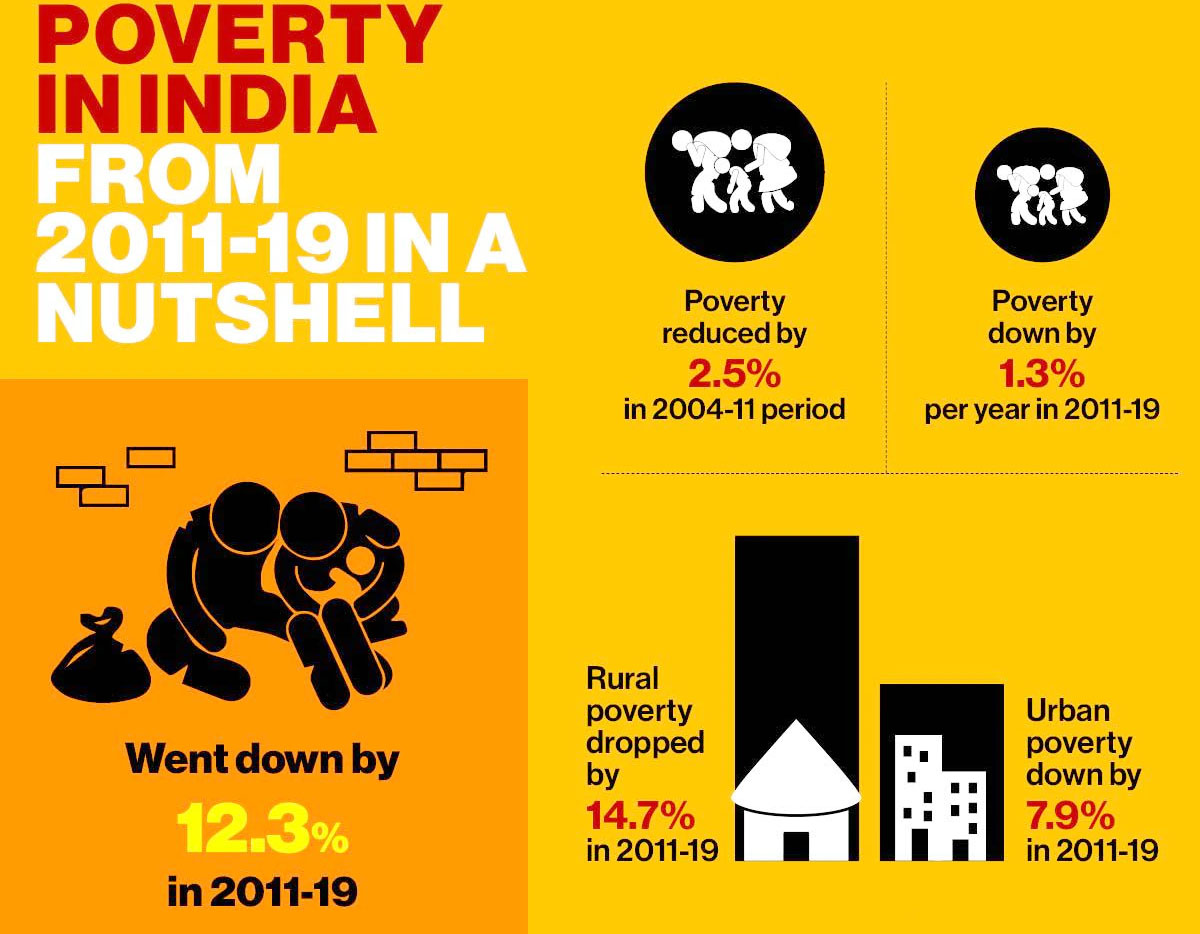Social Justice
Paper on India’s Poverty: World Bank
- 20 Apr 2022
- 5 min read
For Prelims: World Bank, IMF, Poverty, NSSO, Poverty Related Initiatives.
For Mains: Important International Institutions, Poverty in India and Related Issues.
Why in News?
Recently, the World Bank published the paper titled 'Poverty has Declined over the Last Decade But Not As Much As Previously Thought'.
- The paper came close on the heels of a working paper published by the International Monetary Fund (IMF) saying India has almost eradicated extreme poverty and brought down consumption inequality to its lowest levels in 40 years through state-funded food handouts (Public Distribution System).
What are the Key Highlights of the Report?
- Decline in Extreme Poverty: Extreme poverty in India was 12.3% points lower in 2019 compared with 2011, as poverty headcount rate declined from 22.5% in 2011 to 10.2% in 2019, with a comparatively sharper decline in rural areas.
- Slight moderation in consumption inequality since 2011, but by a margin smaller than what is reported in the unreleased National Sample Survey -2017.
- The extent of poverty reduction during 2015-2019 is estimated to be notably lower than earlier projections based on growth in private final consumption expenditure reported in national account statistics.
- The World Bank defines “extreme poverty” as living on less than USD 1.90 per person per day.
- Rural vs Urban Poverty: Poverty reduction was higher in rural areas compared with urban India as rural poverty declined from 26.3% in 2011 to 11.6% in 2019, while in urban areas the decline was from 14.2% to 6.3% in the corresponding period.
- Rural and urban poverty dropped by 14.7 and 7.9% points during 2011-2019.
- Urban poverty in India rose by 2% in 2016, coinciding with the demonetisation, and rural poverty rose by 10% in 2019.
- Small Farmers: Smallholder farmers have experienced higher income growth. Real incomes for farmers with the smallest landholdings have grown by 10% in annualized terms between the two survey rounds (2013 and 2019) compared to a 2% growth for farmers with the largest landholding.
- The growth in incomes of smallest landholders in rural areas provides more evidence of moderation in income disparity in rural areas.
- Smallest landholders comprise a larger share of the poor population. This income includes wages, net receipt from crop production, net receipt from farming of animal farming and net receipt from non-farm business. Income from leasing out land has been exempted.
What is the significance of the Report?
- The World Bank’s paper is significant as India has no official estimation of recent periods. The last expenditure survey was released in 2011 by the National Sample Survey Organisation (NSSO), when the country had also released official estimates of poverty and inequality.
- It sheds light on how poverty and inequality have evolved since 2011 using a new household panel survey, the Consumer Pyramids Household Survey conducted by Centre for Monitoring the Indian Economy (CMIE).
What are the Major Poverty Alleviation Programs of India?
- Integrated Rural Development Programme (IRDP)
- Pradhan Mantri Awaas Yojana
- National Old Age Pension Scheme
- Annapurna Scheme
- Mahatma Gandhi National Rural Employment Guarantee Act (MGNREGA) 2005
- Deendayal Antyodaya Yojana - National Rural Livelihood Mission (DAY-NRLM)
- National Urban Livelihood Mission
- Pradhan Mantri Kaushal Vikas Yojana
- Pradhan Mantri Jan Dhan Yojana
What is the World Bank?
- About:
- It was created in 1944, as the International Bank for Reconstruction and Development (IBRD) along with the International Monetary Fund (IMF). The IBRD later became the World Bank.
- The World Bank Group is a unique global partnership of five institutions working for sustainable solutions that reduce poverty and build shared prosperity in developing countries.
- Members:
- It has 189 member countries.
- India is also a member country.
- Major reports:
- Ease of Doing Business (Stopped publishing recently).
- Human Capital Index.
- World Development Report.
- Its Five development institutions:
- International Bank for Reconstruction and Development (IBRD)
- International Development Association (IDA)
- International Finance Corporation (IFC).
- Multilateral Guarantee Agency (MIGA)
- International Centre for the Settlement of Investment Disputes (ICSID)
- India is not a member of this.







